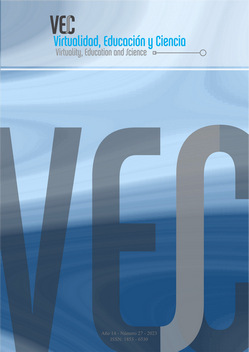Activities in Communicative English: a Perspective from Bloom’s Revised Taxonomy Applied to the Flipped Classroom Model
Keywords:
Communicative English, flipped classroom, cognitive processes, engineering coursesAbstract
This paper presents a partial analysis of the subject Communicative English being taught for the Engineering courses at the Faculty of Engineering and Agronomical Sciences at the National University of San Luis. This elective course was given as a pilot test in the second term of the year 2021. The subject is benefited from the blended learning method, following the Flipped Classroom Model proposed by Fidalgo-Blanco, Sein-Echaluce and García-Peñalvo (2020) and it was, in turn, designed with the aim of complying with the wide range of cognitive processes covered in Bloom’s Revised Taxonomy applied to the Flipped Classroom model. The objective of this paper is to observe and categorise the activities carried out to teach this course both in an e-learning environment, through the learning platform Moodle, and with a traditional classroom-based approach. The achieved results will be helpful to reflect on the strengths and weaknesses and, thus, identify the improvements to be sought in the future.
References
BERGMANN, J. y SAMS, A. (2012). Flip Your Classroom: Reach Every Student in Every Class Every Day. Arlington: IST.
CANALE, M., y SWAIN, M. (1980). Theoretical bases of communicative approaches to second language teaching and testing. Applied linguistics, 1(1), 1-47. http://www.uefap.com/tefsp/bibliog/canale_swain.pdf [18/05/2019].
CHURCHES, A. (2014). La taxonomía de Bloom para la era digital. EDUTEKA: http://www.eduteka.org/articulos/TaxonomiaBloomDigital. [12/03/2020].
DOMÍNGUEZ, M., AGUIRRE CÉLIZ, C., RIVAROLA, M. y BUSSO, N. (2020). El aula invertida: un desafío para la enseñanza de inglés comunicacional en el nivel superior. Revista Virtualidad, Educación y Ciencia, 11(20), 192-201. https://revistas.unc.edu.ar/index.php
/vesc/article/view/27456/29024 [12/02/2020].
DOMÍNGUEZ, M.B, LAURENTI, L. y LUCERO, V. (2018). Innovar para Aprender: el Aula Invertida. En Scagnoli, N. (Ed), Abriendo Caminos hacia Prácticas Educativas Innovadoras (pp. 45-62). San Luis: Nueva Editorial Universitaria.
EVSEEVA, A. y SOLOZHENKO, A. (2015). Use of Flipped Classroom Technology in Language Learning. Procedia - Social and Behavioral Sciences 206, 205-209. https://doi.org/10.1016/j.sbspro.2015.10.006 [12/09/2019].
FIDALGO-BLANCO, A., SEIN-ECHALUCE, M.L. y GARCÍA-PEÑALVO, F.J. (2020). Ventajas reales en la aplicación del método de Aula Invertida- Flipped Classroom - Proyecto: Framework de un ecosistema digital para una sociedad en red interoperable. https://www.researchgate.net/publication/338633685_Ventajas_reales_en_la_aplicacion_del_metodo_de_Aula_Invertida-_Flipped_Classroom [14/10/2021].
HUNG, H. (2014). Flipping the classroom for English language learners to foster active learning. Computer Assisted Language Learning, 28(1), 81-96. http://dx.doi.org/10.1080/09588221.2014.967701 [16/08/2019].
LEDESMA LÓPEZ, A. (2017). El modelo flipped classroom en la asignatura de inglés de 2° de ESO [Tesis de Maestría. Universidad Internacional de La Rioja, Barcelona]. https://reunir.unir.net/bitstream/handle/123456789/6058/LEDESMA%20LOPEZ%2C%20ANNA.pdf?sequence=1&isAllowed=y [12/11/2021].
MARCO COMÚN EUROPEO DE REFERENCIA PARA LAS LENGUAS: APRENDIZAJE, ENSEÑANZA, EVALUACIÓN - Ministerio de Educación, Cultura y Deporte, Subdirección General de Cooperación Internacional, 2002. https://cvc.cervantes.es/ensenanza/biblioteca_ele/marco/cvc_mer.pdf [16/08/2019].
MORGAN-SCOTT, S.M., CARBONELL-LIMONTA, W. y LIMONTA-VILLALÓN, F. (2016). Integración de las habilidades comunicativas y las profesionales en la enseñanza del Inglés con fines específicos. Revista EduSol, 16(54), 49-62. https://www.redalyc.org/jatsRepo/4757/475752820030/475752820030.pdf [2/12/2021].
Downloads
Published
Issue
Section
License

This work is licensed under a Creative Commons Attribution-NonCommercial 4.0 International License.
The generation of derivative works is allowed as long as it is not done for commercial purposes. The original work may not be used for commercial purposes.


